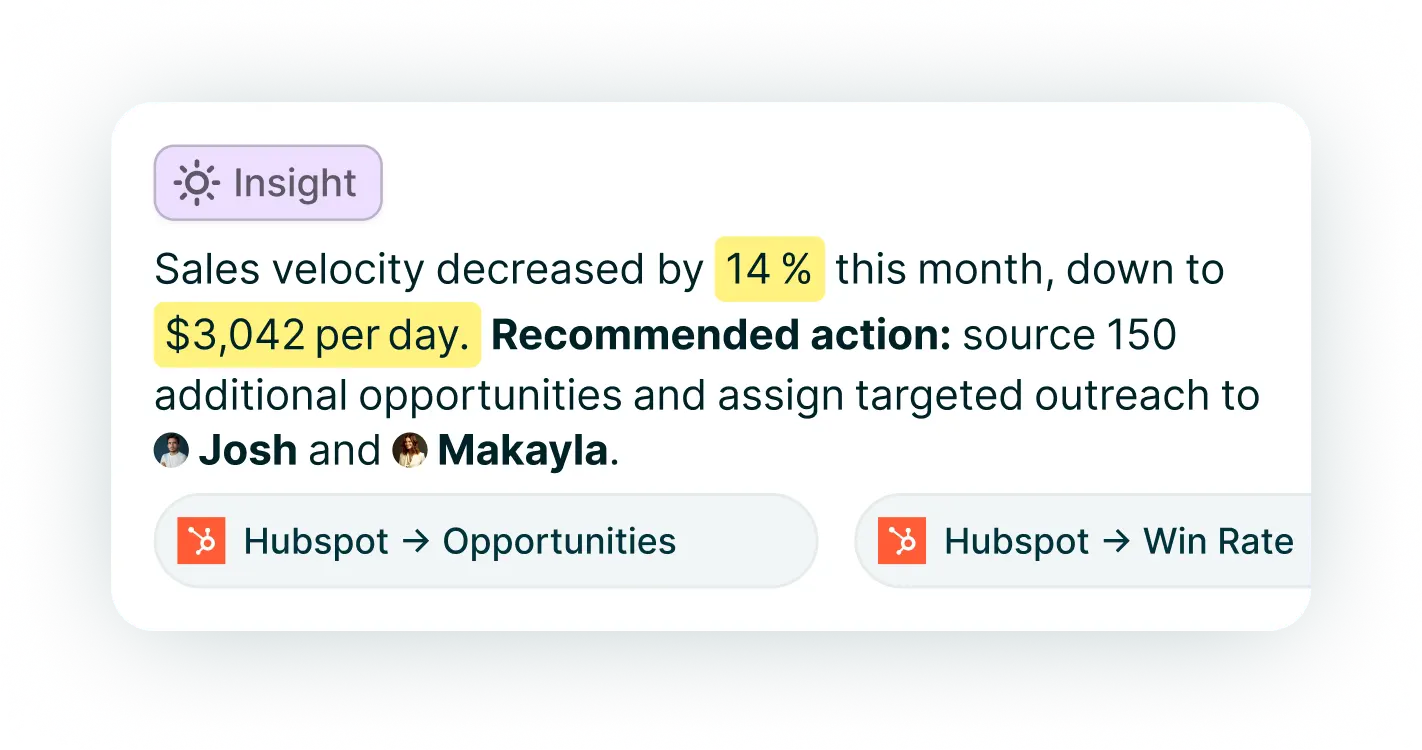
Sales Velocity: How to Calculate It and Accelerate Your Sales Growth
min read

Ben Hale
25%. That’s how much faster revenue grows for companies that actively manage their sales velocity.
Speed makes the difference between hitting quota and missing the mark. If you’re tired of scrambling at end of quarter because deals are crawling through the pipeline, you need to zero in on a metric that matters: sales velocity. Velocity tells you how fast your business is generating revenue, and it could be the key to hitting your aggressive targets.
In our collective decades of B2B sales experience, we’ve learned a thing or two about sales velocity (sometimes the hard way). You can have a quality product and a talented sales team, but if your sales process is slow or inefficient, growth will still stall. Sales teams play a critical role in driving revenue and managing customer relationships, helping to close deals faster and optimize the sales pipeline. In this article, we’ll break down exactly how to calculate your sales velocity and more importantly, how to pull each of the four levers that drive it.
By the end of this article, you’ll have the tools you need to get deals flowing faster and predictably. You’ll understand the importance of measuring sales velocity, using up to date data for accurate analysis, and how a sales manager can interpret sales velocity data to guide and optimize the performance of your sales team.
Why Sales Velocity Matters
Sales velocity isn’t just a vanity number; it’s a holistic gauge of your revenue engine’s performance. Research backs this up; companies that regularly track sales velocity see higher growth rates than those who don’t. In other words, paying attention to sales velocity forces you to focus on the quality and efficiency of your sales process, not just raw totals.
If you own a sales target, predictable performance is the name of the game**.** Tracking sales velocity helps you understand the buyer journey and identify what is working or causing delays in closing sales. Finding the bottlenecks is the best way to compress your sales timeline without sacrificing quality. Analyzing pipeline velocity helps pinpoint where prospects are getting stuck in the sales pipeline, so you can address bottlenecks and optimize each stage for better results. The faster you can move qualified prospects from interest to close (and the more of them you can move), the faster your company grows.
Velocity also helps you with sales forecasting. When you understand your sales velocity better, you can make more accurate projections, adjust your strategies, and allocate resources more effectively. By tracking both sales velocity and pipeline velocity, you can more reliably predict future revenue and generate revenue more efficiently by optimizing your sales pipeline.
How to Calculate Sales Velocity
Before we talk about improving sales velocity, let’s make sure we can measure it—and that starts with calculating sales velocity accurately and consistently.
Sales velocity is the rate at which you generate revenue from your pipeline. The formula is:
Sales Velocity = (Number of Opportunities × Average Deal Value × Win Rate) / Sales Cycle Length
This is known as the sales velocity equation. To get meaningful insights, it’s critical to use accurate sales velocity numbers and ensure your data is up to date.
For example, if you have 50 opportunities, an average deal size of $10,000, a win rate of 20%, and a sales cycle of 60 days, your sales velocity would be:
(50 × $10,000 × 0.20) / 60 = $1,666.67 per day
Here’s another sales velocity example: If your team has 30 opportunities, a $15,000 average deal size, a 25% win rate, and a 45-day sales cycle, your sales velocity is (30 × $15,000 × 0.25) / 45 = $2,500 per day. A sales velocity report can help you visualize these metrics and track changes over time.
There are four levers in the formula: number of opportunities, average deal value, win rate, and sales cycle length. Analyzing sales velocity across different market segments (like SMB, mid-market, and enterprise) and over consistent time periods gives you deeper insights into where your pipeline is strong or needs improvement. This approach ensures your sales velocity analysis is actionable and relevant for your business decisions.
Sales Velocity Formula
Thankfully, the sales velocity formula is straightforward:
Sales Velocity = (Number of Opportunities × Average Deal Size × Win Rate) ÷ Length of Sales Cycle

This formula gives you a metric typically expressed as revenue per time, for example, dollars per day or per month. It literally tells you how much revenue you’re generating in a given period, on average. Think of it as the speedometer for your sales engine: how quickly are deals turning into dollars?
Let’s break down each component of the formula:
Number of Opportunities
How many qualified deals or sales opportunities are in your pipeline during the period? (Not just leads. Real opportunities likely to convert.) Tracking the number of sales opportunities, especially high quality leads and potential buyers, is crucial for understanding pipeline health and maximizing conversion rates.
Average Deal Size
The typical revenue per deal. If you have a mix of deal sizes, this is the average value of a closed deal. Consider your average deal value, average purchase amount, and average purchase, as well as the impact of high value deals. Both closed deals and deals closed contribute to your total revenue and help determine this metric.
Win Rate
The conversion rate of opportunities to wins. For instance, a 25% win rate means you close 1 out of 4 qualified opportunities on average. Pay attention to your win rate percentage, average win rate, and the number of sales won. The formula often uses deal value x win to reflect the impact of both deal size and win rate on sales velocity.
Sales Cycle Length
The average time (in days or months) it takes to close a deal, from first contact to signed contract. This covers the entire sales cycle, including all stages of the sales funnel and the buying process, and can vary based on deal complexity and industry.
Plug these numbers into the formula, and you get a velocity metric. For example, if you had 50 opportunities in a quarter, an average deal size of $20K, a win rate of 20%, and a sales cycle of 60 days, your sales velocity would be:
(50 Opportunities × $20,000 Deal Size × 20% Win Rate) ÷ 60-Day Sales Cycle =$3,333 in revenue per day.
In this scenario, your team brings in about $3,333 of new business on an average day. This number going up means you’re increasing how fast revenue comes in. If it decreases, your growth is slowing.
Tracking the number of deals, total revenue, and average customer lifetime value or customer lifetime value is especially important for SaaS or subscription businesses, where recurring revenue and long-term relationships drive success.
There are four variables that feed into sales velocity. That means you have four levers to pull to sell faster. Let’s dive into each one and explore how you can crank them up for higher velocity.
The Four Drivers of Sales Velocity
Improving sales velocity isn’t a one-time switch you flip; it’s about continuously tweaking the four inputs of the formula. The beauty is that small wins in multiple areas can compound into a big overall jump in velocity. McKinsey found that SaaS companies optimizing each component of sales velocity saw 10–15% higher annual contract values than competitors. Optimizing the drivers of sales velocity can accelerate deal cycles, improve win rates, and increase sales efficiency.
1. Increase the Number of Opportunities
More opportunities = more chances to win. This is the most intuitive lever: if you can increase the volume of quality deals in your pipeline, you’ll close more business in the same timeframe. Increasing the number of quality opportunities directly improves your team's sales velocity. It means you achieve targets faster and more predictably.
Note the keyword “quality.” It’s not just about dumping more leads into the top of the funnel; unqualified leads will clog up the works. The quality of leads is more important than the quantity. In fact, many teams report that finding enough qualified leads is their biggest challenge.
Outbound prospecting and content marketing are two of the most common ways to generate new opportunities. Aligning marketing efforts with sales—such as targeting the ideal customer profile and qualifying leads—ensures that the opportunities generated are high quality and more likely to convert.
How to Move the Needle
To boost opportunities the right way, consider strategies like refining your ideal customer profile and targeting prospects who really match it. One study found companies that implemented these strategies saw a 33% increase in opportunities generated compared to a more generic approach. Why? Because it focuses your efforts on high-probability, high-value targets, essentially fishing in a well-stocked pond instead of the open ocean.
Other tactics include ramping up your outbound prospecting, investing in content marketing or events to draw inbound interest, and incentivizing referrals from happy customers. More at-bats means more hits. But remember, don’t trade quality for quantity. It’s better to bat .200 on 50 solid opportunities than whiff 100 long-shots.
2. Increase the Average Deal Size
The second lever is average deal size: essentially, it’s how much revenue you generate per win. Raising this number means you get more revenue for each deal you close, which turbocharges your sales velocity without adding extra prospects. Increasing your average deal size is crucial for improving sales performance. It encourages your team to uncover deeper customer needs and deliver greater value in every engagement. It’s like the difference between catching a bunch of small fish versus a few big ones; both can fill the boat, but bigger fish feed more people with the same effort.
How to Move the Needle
So how can you land bigger deals? Go big and don’t go home. Start with value-based selling: ensure your product’s pricing reflects the real value it delivers, and train your team to communicate that value confidently. Sometimes companies find they’ve been underpricing; correcting it can lift deal sizes immediately. In fact, research shows even a 1% improvement in pricing can yield an 11% increase in profit, which illustrates how sensitive your bottom line is to price and deal value.
Beyond pricing, consider tactics like upselling and cross-selling. Don’t just sell Product A; if Product B or an add-on service will help the customer even more, bundle it in or position it down the line. Many SaaS companies use a “land and expand” model for this reason: land a small deal to start, then expand the account. The key is to ensure your team is looking for those expansion opportunities. For example, if you close a deal for 100 licenses of your software, plan a check-in for six months later. If the customer is seeing success, then it’s time to propose more licenses or an enterprise package.
Another approach is targeting higher-value customer segments. If you’ve traditionally sold to small businesses, consider pursuing mid-market or enterprise clients who naturally have bigger budgets (albeit longer sales cycles).
Don’t forget to equip your sales team as well. Give them case studies and ROI calculators that show the financial impact of a larger deal. If a prospect clearly sees that your solution will save or earn them $500K, negotiating for a $100K deal instead of a $50K deal becomes much easier.
3. Improve Your Win Rate (Conversion Rate)
This lever is all about conversion efficiency: out of the opportunities you have, how many do you actually win? Improving your win rate means you get more sales from the same number of leads; it’s raising your batting average. This is often the fastest way to boost sales velocity because you’re not spending more on marketing or working more leads; you’re simply closing a higher percentage of what’s already in play.
How to Move the Needle
To bump up win rates, sell smarter. Start at the top of the funnel: lead qualification. Pursuing better qualified leads keeps your sales velocity number healthier. If your win rate is low, it could be a sign that a lot of shaky prospects are entering your pipeline. Tighten your Ideal Customer Profile criteria and make sure sales and marketing agree on what a qualified lead looks like. Then disqualify any leads who don’t meet your criteria as soon as you can. It’s better for sales reps to work 10 good opportunities and win 5, than slog through 30 so-so opportunities to win the same 5 deals.
Next, invest in sales enablement and training. Give your team the content, tools, and coaching they need to win more often. There’s evidence that companies with a formal sales enablement program achieve 10–15% higher win rates than those without one. That’s a huge uplift in conversion efficiency.
Think about it: if you currently win 1 out of 5 deals (20% win rate), a 10-15% relative improvement could take you to a win rate around 22–23%. That might not sound dramatic, but over a year of opportunities, it nets a good amount of extra revenue with zero increase in leads.
Examine your sales process for friction points as well. Are prospects dropping out after demos? Maybe your reps need better demo training or the marketing team can provide stronger case studies at that stage. Are deals stalling at procurement or legal? You could templatize contracts or pre-negotiate common terms to smooth that out. Improving win rate is about removing obstacles and sharpening skills at each stage of the funnel.
4. Shorten the Sales Cycle
The final lever is sales cycle length: how long it takes, on average, to close a deal. This is the denominator in the sales velocity formula, so shortening your cycle directly speeds up your revenue. Time is a critical factor in sales. There’s an old saying: “Time kills all deals.” The longer a deal drags on, the greater the chance something goes wrong. The prospect’s priorities change, a new competitor swoops in, budgets vanish, you name it. A faster sales cycle not only means you book revenue sooner, it can also mean a higher probability of winning.
How to Move the Needle
Time kills all deals, so don’t let yours die of old age. How can you close deals faster without rushing the buyer? One way is to eliminate unnecessary delays in your process. For example, if getting a proposal or contract takes a week due to back-and-forth, consider using templates and tools to cut that to a day. Sales automation tools can also streamline repetitive tasks to improve your sales velocity.
Speed to lead is another huge factor. When a lead raises their hand, how fast do your reps respond? Research shows that reps who follow up immediately or within a few hours are far more likely to convert the lead than those who wait a day or two. Responsiveness signals reliability, and it keeps the prospect’s momentum and interest high. We always encourage teams to strike while the iron is hot. If someone downloaded your whitepaper or requested a demo, get that meeting scheduled now.
Be persistent with follow-through. Most prospects won’t sign after the first meeting, or even the first proposal. In fact, many deals require at least 4-5 follow-ups to finally get to “yes,” yet most salespeople give up after one or two tries. Don’t be “most salespeople.”
There’s a fine line between persistence and annoyance, but a polite follow-up after a few days or a week, bringing new value each time, can dramatically improve your close rate and speed. We often remind the team of a striking statistic: around 80% of prospects say “no” four times before they say “yes,” and yet 92% of reps quit after the fourth no. If you push a bit further (professionally), you’ll be in that rare 8% who capture the majority of deals simply because you stayed in the game.
Finally, look at where deals stall in your pipeline. Is it waiting on approvals, either on your side or the customer’s side? Perhaps empower your reps with a playbook to navigate a customer’s internal bureaucracy, or give managers discretion to approve custom terms more quickly. If legal review is a bottleneck, get your legal team involved early for big deals or use standard contracts for smaller ones. Every day you trim off the typical process is more revenue, sooner. Multiply that by dozens of deals, and it makes a big impact.
The Bottom Line: Speed Is a Competitive Edge
When it comes down to it, sales velocity is about working smarter and faster at the same time. By now, you’ve seen how tweaking the number of opportunities, deal size, win rate, or sales cycle (better yet, all of them together) can get revenue flowing more quickly. Remember, it’s not an abstract formula, it’s a practical framework to pinpoint where you can get better.
Now, it’s your turn. Apply the sales velocity formula to your own data and identify your biggest lever. Is it filling the funnel with better leads? Training the team to convert more deals? Packaging bigger offers? Streamlining the process? Rally your team around the idea that speed and efficiency in sales can be engineered and improved. Small gains across these four areas will compound into faster growth.
Chief gives sales leaders intelligence on which exact pipeline stages are slowing them down. Instead of guessing which lever to pull, you get insight into velocity drivers and recommended actions to help you increase speed and consistency.

If you’re ready to see how much faster your pipeline could move, request a free pipeline analysis from Chief. We’ll show you hidden friction points and surface the specific actions that can help your team hit its number faster—and more often.
.svg)
.%20(3).webp)

